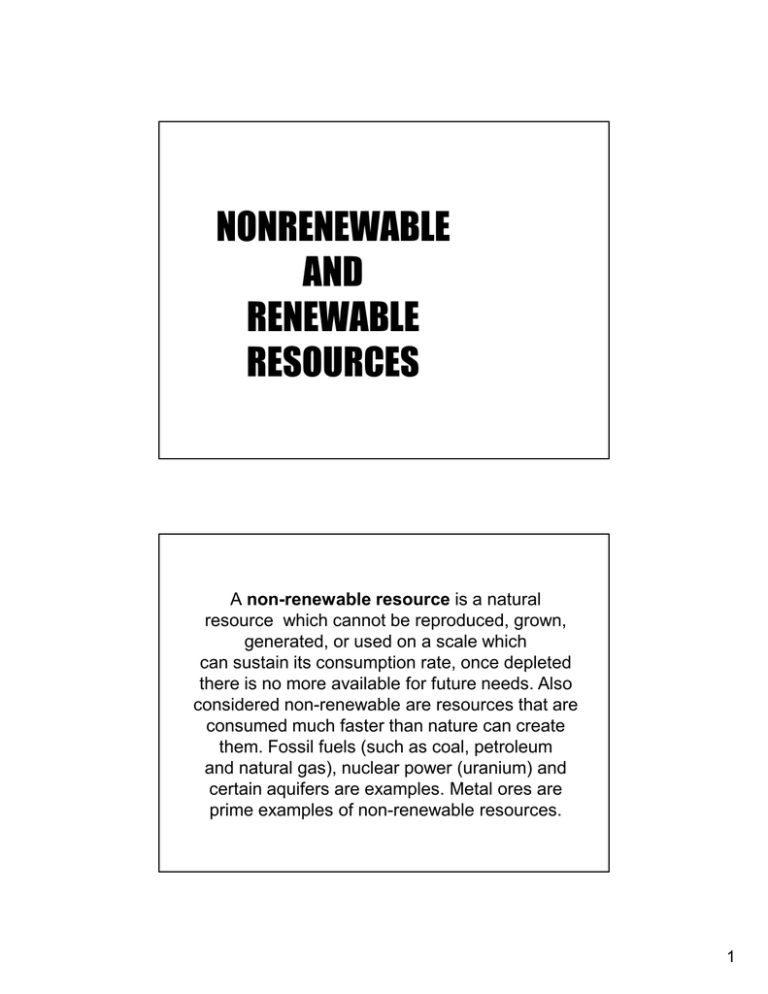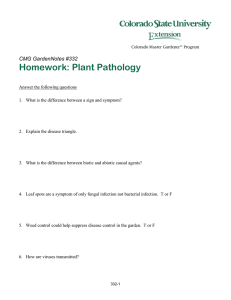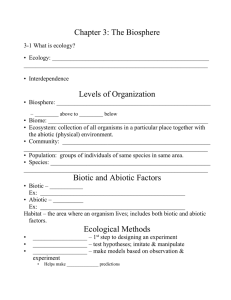NONRENEWABLE AND RENEWABLE RESOURCES
advertisement

NONRENEWABLE AND RENEWABLE RESOURCES A non-renewable resource is a natural resource which cannot be reproduced, grown, generated, or used on a scale which can sustain its consumption rate, once depleted there is no more available for future needs. Also considered non-renewable are resources that are consumed much faster than nature can create them. Fossil fuels (such as coal, petroleum and natural gas), nuclear power (uranium) and certain aquifers are examples. Metal ores are prime examples of non-renewable resources. 1 A renewable resource is a natural resource with the ability to reproduce through biological or natural processes and replenished with the passage of time. Renewable resources are part of our natural environment and form our eco-system. Resources such as timber (when harvested sustainably) and wind (used to power energy conversion systems) are considered renewable resources. Renewable Resource • Timber • Air • Animals • Trees • Hydro Power • Geothermal Power • Plywood • Sugar Cane • Corn • Leather • Wood COMPONENTS OF ENVIRONMENT 2 An organism’s environment has both abiotic and biotic components. - Abiotic components are nonliving chemical and physical factors such as temperature, light, water, and nutrients. -Biotic components are living factors such as other organisms. An ecosystem consists of all abiotic factors plus all organisms that exist in a certain area Abiotic factors are the non-living Components of the Environment • Abiotic factors include: – Sunlight – Water – Temperature – Wind – Soil/nutrients – Special events such as: • Fires • Hurricanes • Floods • Volcanic eruptions • Tsunamis 3 Abiotic Factors • Temperature also affects the distribution of plants and animals. • As a rule, temperature are lower as you move towards the poles or as you climb in elevations. For this reason arctic or subarctic plant communities can be found at high elevations in the tropics. • In the temperate latitudes living organisms must be able to tolerate the temperature extremes of summer and winter. nter. • In the tropics there is very little seasonal change and many organisms have a narrow range of temperature tolerance. Other Abiotic Factors Calcium: The lack of availability of calcium will restrict the distribution of land snails. If there is no calcium a shell can’t be secreted. Sand: the size of the sand grains in the soil can impact animal that are burrowers. Nitrogen: Not just nitrogen, but nitrate (NO3). This is the form of nitrogen used by plants. When nitrate is not readily available in the soil, some plants supplement it with a meat diet. (insectivorous plants). 4 Biotic Factors • A living organism is also affected by the living components of its environment. • Competition exists for available food resources. • Predators feed on members of the population. • Microbes can bring diseases. • There may be competition for nesting space. • Plants may compete for the light needed to carryout photosynthesis. • These are many other biological factors determine the success of an individual or species. 5


